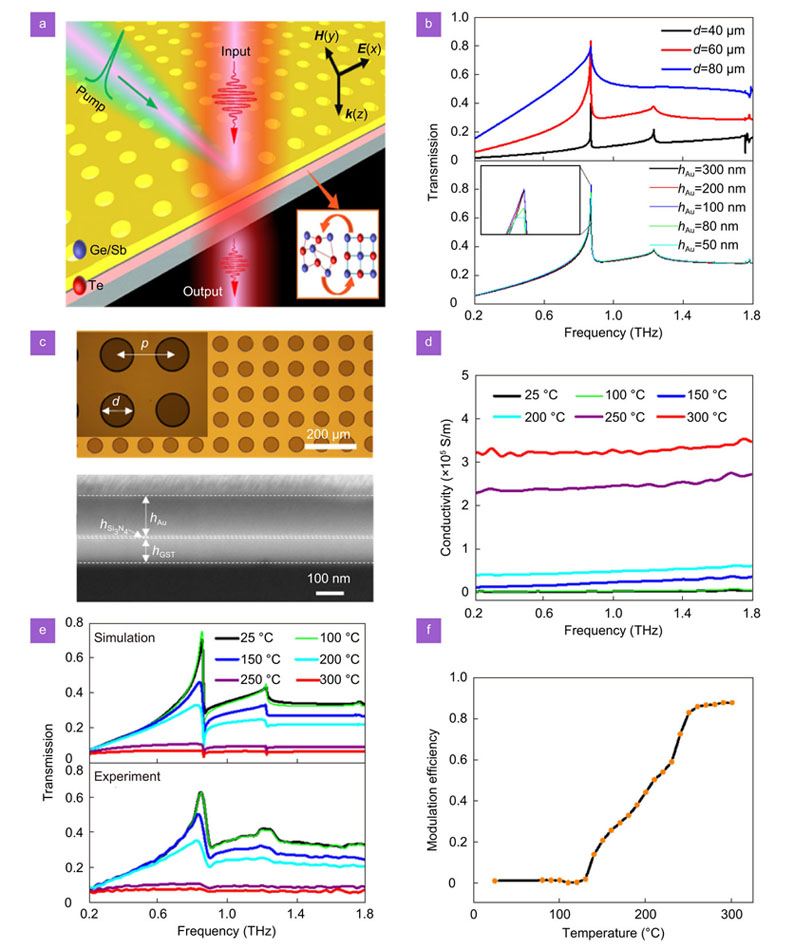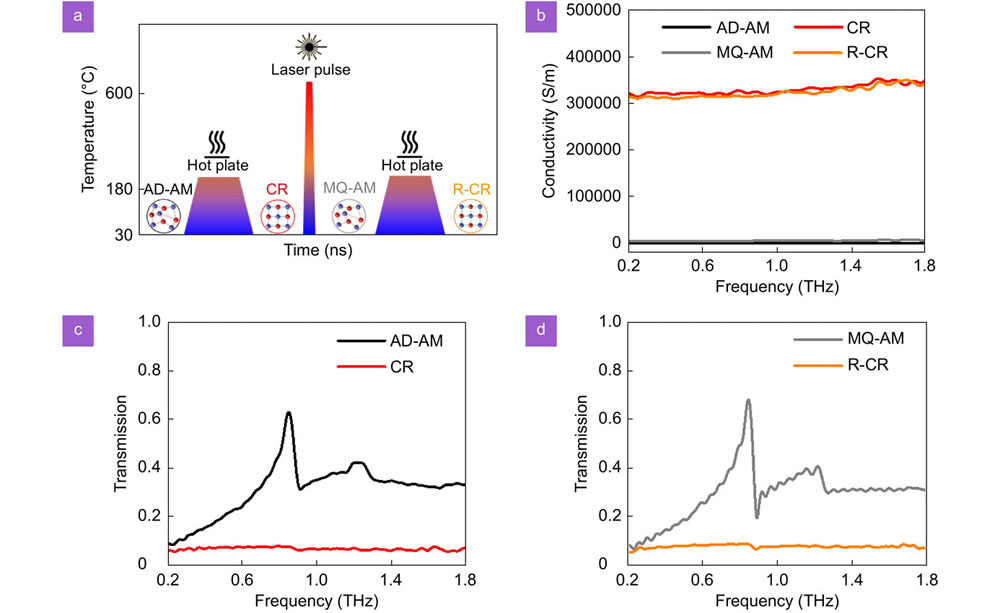Tun Cao, Meng Lian, Xieyu Chen, Libang Mao, Kuan Liu, Jingyuan Jia, Ying Su, Haonan Ren, Shoujun Zhang, Yihan Xu, Jiajia Chen, Zhen Tian, Dongming Guo. Multi-cycle reconfigurable THz extraordinary optical transmission using chalcogenide metamaterials[J]. Opto-Electronic Science, 2022, 1(1): 210010-1
Search by keywords or author
- Opto-Electronic Science
- Vol. 1, Issue 1, 210010-1 (2022)

Fig. 1. Configuration of the EOT metamaterials for the THz region. (a ) Schematic of the all-optical, reconfigurable, non-volatile phase-change metamaterials induced EOT switch: single nanosecond pulsed laser transits a 100 nm thick GST225 film reversibly between the amorphous and crystalline states. (b ) The FEM simulated transmission spectra of the chalcogenide metamaterials with the amorphous state at the various diameter of d = 40, 60, and 80 μm (top panel) and various heights of hAu = 50, 80, 100, 200, and 300 nm (bottom panel). (c ) Optical microscope (top panel) and FIB cross-sections (bottom panel) images of the EOT metamaterials. The geometrical parameters of the subwavelength holes array are p = 100 μm, d = 60 μm, respectively; the thicknesses of the Au and GST225 layers are hAu = 0.2 μm and hGST= 0.1 μm, respectively. (d ) The temperature-dependent optical conductivity (σ) of the 100 nm thick GST225 film. (e ) The behavior of resonant transition in the metamaterials: numerical simulated (top panel) and experimental measured (bottom panel) transmission spectra at the various temperatures ranging from 25°C to 300°C. The reduction of the peak intensity can be experimentally and theoretically observed by increasing the temperature. (f ) The modulation efficiency against the annealing temperature varied from 25 °C to 300 °C.

Fig. 2. In sequence processing for the reversible state change. (a ) Schematic of the reversible state change of the GST225 layer hybridised with an EOT metamaterials: the AD-AM GST225 is initially heated above TC=250 °C to switch to the CR-GST225 via a hot plate. A single ns pulsed laser is transited to thermally anneal the CR-GST225 layer above TM=600 °C that reamorphises the CR-GST225. Consequent quenching leads to the MQ-AM GST225. A temperature above TC=250 °C but below TM=600 °C is needed to recrystallise the MQ-AM GST225, which is achieved by using a hot plate. (b ) The σ of 100 nm thick GST225 film at the various structural states of the as-deposited amorphous (AD-AM, black line), crystalline (CR, red line), melt quenched amorphous (MQ-AM, grey line), and re-crystallised (R-CR, orange line) over a spectral range of 0.2-1.8 THz. Experimental realisation of reversibly tunable EOT effect: the THz-TDS measurement of the transmission spectra of the chalcogenide metamaterials with the various structural phases of (c ) AD-AM, CR and (d ) MQ-AM, and R-CR.
Fig. 3. Numerical simulation of total E- field distribution along the x-z plane of the metamaterials at the various temperatures of (a ) 25 °C, (b ) 150 °C, (c ) 200 °C, and (d ) 300 °C.
Fig. 4. (a ) Measured transmission spectra of the EOT chalcogenide metamaterials for twenty switching times. (b ) The values of transmission peaks for the amorphous (shown by black dots) and crystalline (indicated by red dots) states with twenty switching times. The morphology (top panel) and cross-sectional (bottom panel) images of the chalcogenide metamaterials (c ) before and (d ) after 20 transition times.

Set citation alerts for the article
Please enter your email address



